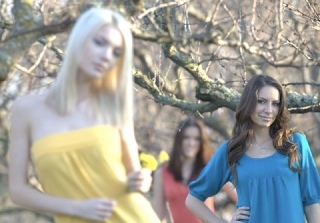Just when you thought we had seen it all, along comes the Lytro camera. This technological marvel allows you to focus the photograph, after you have taken the picture, not before!
Countless articles have been written over the years, including some here, on how to make sure you get pin-sharp pix, with or without AutoFocus (AF). It now looks as if you can forget all that with the new Light Field technology which is being developed by Lytro Inc in the USA.
 Focus foreground.
Focus foreground.
This technology puts a whole new perspective on the genre of ‘point and shoot’ photography.
According to the Lytro Press Release, it is developing a “light field” camera for consumers that will forever change the way people take and experience pictures. Later this year, Lytro will start selling light field cameras that can capture all of the light rays in a scene to offer photographic capabilities never before possible, such as focusing a picture after it’s taken. Lytro cameras will also create interactive, living pictures that can be endlessly focused and refocused by both the photographer and the viewer, bringing new creative possibilities to photography.
Lytro’s light field camera probably represents the most significant shift in photography since the transition from film to digital in 1988. The light field fully defines how a scene appears, from the foreground to the background and everything in between. Unlike conventional cameras, which can only record a scene in two dimensions, light field cameras can capture all of the light traveling in every direction through a scene in four dimensions. A light field picture taken with a Lytro camera can be manipulated after the fact in ways not possible with editing software.
 Background focus.
Background focus.
“This is the next big evolution of the camera,” said CEO and Founder Dr. Ren Ng. “Lytro is introducing Camera 3.0, a breakthrough that lets you nail your shot every time and never miss a moment. Now you can snap once and focus later to get the perfect picture.”
Since the camera doesn’t focus before a photo is taken, people will no longer miss the decisive moment due to the conventional delay of the lens autofocusing as you press the shutter button.
Lytro creates interactive, living pictures that will allow viewers to immerse themselves in a living picture to discover and focus in on new details by simply clicking on different parts of a picture.
By using all of the available light in a scene, light field cameras can capture better pictures in remarkably low light environments without the use of a flash.
Using the full light field, Lytro cameras provide an immersive 3D picture that goes beyond the conventional stereo 3D by, for example, controlling the perspective view of a scene.
“Lytro’s breakthrough technology will make conventional digital cameras obsolete. It has to be seen to be believed,” said investor Marc Andreessen, general partner at Andreessen Horowitz.
“Humans have a deep desire to capture the experience of their lives and share it visually with others,” said Emmy-award winning multimedia journalist Richard Koci Hernandez. “From early man’s cave paintings more than 30,000 years ago to the first people posing for daguerreotype photos wearing iron collars to stay still in the 1800s, humans have gone to great lengths to tell visual stories. Light field cameras are the next step in that picture revolution.”
The digital still camera market is large and growing with $38.3 billion in worldwide revenue in 2010 and expectations to increase to $43.5 billion worldwide by 2015. Visual storytelling is universal, with 60 billion photos shared on Facebook in 2010, projected to reach 100 billion photos by this summer.
Undoubtedly this computational approach to the reproduction of images is the way of the future, the way forward. And equally as predictable, will be the howls of rage from the ‘conventional’ photography bloc throughout the world – the same group that pooh-poohed the digital camera as giving nowhere near the same precision and clarity as the now long dead film cameras. However, this light field technology should mean you will never miss another photo opportunity gain!
If you would like to experience what is coming, visit the Lytro Picture Gallery www.lytro.com/picture_gallery.




